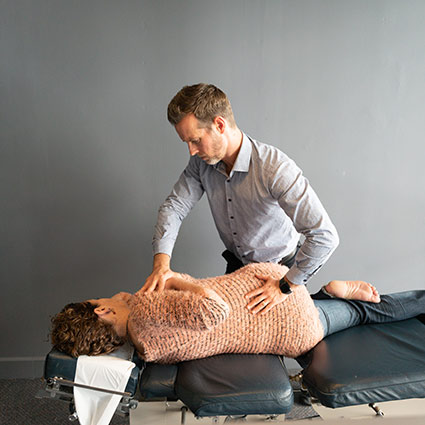
Lower Back Pain Relief in Bondi Junction
Relief with Chiropractic Care
Back pain is all too common, experienced by one in six Australians each year. It can begin in early childhood and may resolve quickly, while other episodes seem to never truly resolve.
There are several different conditions that can result in low back pain. At Health Odyssey Chiropractic, it’s our goal to get you out of pain as quickly as possible.
Types of Pain
Sacroiliac Syndrome
Pain in the sacroiliac joint, ligaments or capsule can result from trauma, abnormalities in posture or biomechanics, ligament laxity, joint fixation and leg length inequality. The symptoms involve a sharp, stabbing, localised pain that may refer into the buttocks, low back and back of the leg. Discomfort may increase with movement and is relieved when lying down.
Leg Length Inequality
Unequal leg length can be due to bones that were shortened from trauma, infection, childhood disease, neoplasms and neuromuscular disease like polio or cerebral palsy. It can also be caused by biomechanical disturbances like joint fixations and muscle imbalances.
Those with leg length inequality experience an abnormal gait, long-term degenerative changes, scoliosis and pain syndromes in the neck, low back, hip, knee, foot and ankle.
Lumbar Facet Syndrome
When the lumbar facet joints or capsules are affected by a sprain or biomechanical dysfunction, joint inflammation and degeneration can result. The pain can be dull and achy or sharp and is localised to a specific point, referring into the leg and buttock.
Lumbar Sprain/Strain
A sprain or strain in the lumbar spine is caused by damage of the ligaments or muscles from poor posture, overuse, trauma or muscle imbalance. Its severity ranges from mild at Grade 1 to severe at Grade 3. The signs include stiffness or pain immediately or sometime after an injury has occurred. The pain may radiate up the spine or into the legs and buttocks.
Lumbar Disc Herniation
When the disc material in between the vertebrae protrudes, it compresses the spinal cord and nerves. It’s caused by overloaded discs, trauma, poor posture, twisting and flexion movements, muscle imbalances and factors such as poor core strength, lack of exercise, abnormal biomechanics, poor nutrition and disc degeneration.
Lumbar disc herniation is characterised by the onset of low back pain, possibly with leg pain, which is sharp and shooting in nature and increases with walking, standing, sitting for long periods, sneezing or coughing. You may also have a previous history of mild back pain.
Lumbar Degenerative Joint Disease
Joints can become degenerated because of abnormal biomechanics, poor posture, metabolic or genetic predisposition, fractures, trauma and repetitive joint motions. The symptoms include joint pain that develops slowly and becomes dull or achy. There may be stiffness in the morning and pain can be relieved by rest. Pain can be forceful and refer up and down the spine as well as into the legs and buttocks.
Spondylolisthesis
When a vertebra is moved forward on another vertebra from degeneration, poor posture, trauma and other pathologies, spondylolisthesis can result. It’s commonly found in those who perform repetitive flexion and extension movements, such as dancers or gymnasts. The symptoms include low back pain. More severe cases involve compression of the spinal cord, which can result in loss of control over the bladder and bowels and neurological issues like numbness in the legs and muscle weakness.
Lumbar Instability
The increased motion that results from compromised structural integrity of one or more joints causes instability in the lumbar spine. It may be caused by sprains and strains, spondylolisthesis or repetitive motions. The symptoms include recurring lower back pain that is relieved by back support and rest. It increases with small twisting movements or prolonged postures.
Cauda Equina Syndrome (CES)
The nerves that form the lumbar spinal cord are called the cauda equina nerves. When compressed by trauma, abscess, tumours or invertebral disc disease, your neurological function is compromised. The symptoms of this disorder include sciatica, low back pain, loss of sensation, muscle weakness, numbness in the buttock, and bowel or bladder problems.
Piriformis Syndrome
The sciatic nerve can be compressed by the piriformis muscle, resulting in pain in the buttock and back of leg. There may be trigger points present. This syndrome usually does not involve any form of trauma.
Ankylosing Spondylitis
This autoimmune inflammatory form of arthritis primarily affects the sacroiliac joints, resulting in a progressive stiffening of your spine. It occurs most often in younger males who may complain of chronic low back pain or stiffness, which radiates into the thigh and buttock.
Aortic Abdominal Aneurysm
An enlarged or weak abdominal aorta, which is usually associated with atherosclerosis, can rupture, resulting in mild to severe pain in the low back and abdominals. There may be no symptoms present until the rupture occurs.

Lower Back Pain Relief Bondi Junction NSW | (02) 9389 7800


